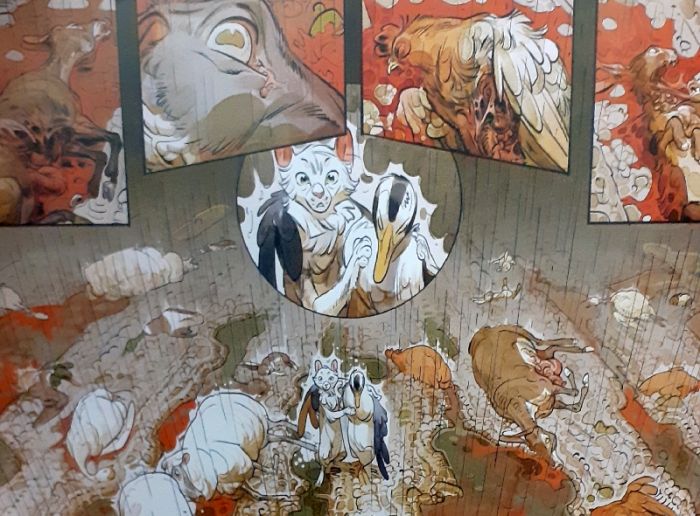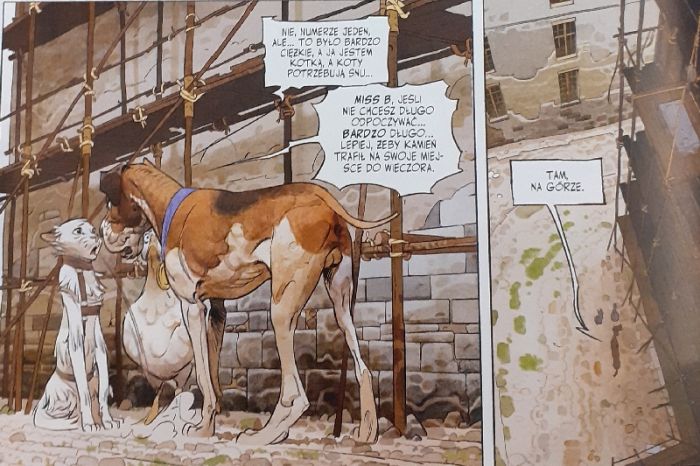I read the animal farm for the first time only this year. I knew what to expect, but the reading was still frightening. In the era of ubiquitous populism, the satire on the Russian revolution is still relevant.
George Orwell’s work has received several adaptations over the years. There was both an animated film and an (hm) acting film. The only thing that appeared in the form of pictures were Norman Pett’s comic strips, published in the 1950s. Surprisingly little for such a recognizable title. And here comes Xavier Dorison, one of the most important and prolific French artists. His Animal Castle, however, is not a translation of the British writer’s novel into a comic book. The screenwriter proposes a much more interesting approach – he takes the same starting idea, but builds his story on its basis.
Jump over the fence
The main character of the Animal Castle is the single mother of Miss Bangalore the cat. During the day he deals with the transport and laying of bricks, and at night he raises his kittens. She is one of the many serfs who do slave labor for minimal rations. At the top of this chain, this time there are not pigs, but Silvio the bull (it is not surprising that the comic book in Poland was published by Taurus Media), who rules together with his loyal dogs. The first attempt at revolt, in which herbivores try to overthrow power by force, ends in a bloody slaughter. That is why Miss Bangalore, along with the wandering rat Azelar and the rabid rabbit Caesar, are planning a more subtle, grassroots revolution.
The castle openly argues with Folwark. As Dorison himself states in the preface, “Orwell hit the nail on the head. But he couldn’t see everything. ” In the comic, the emphasis is not so much on how animal dictatorship came about, but on an element that was missing in the original – the resistance. The French screenwriter has a more optimistic vision of the world and thus shows that where there is oppression, there will always be individuals who will fight it (which is evident even in the current situation in the country …). In the aforementioned preface, Lech Wałęsa himself appears as one of the sources of inspiration. This approach to the classics – combining familiar elements with new ones – turned out to be a great script writer. The French is able to combine dramatic elements with political satire with as good a result as the author of the original.

Under the tail
Felix Delep’s drawings are brilliant. A few months ago, when Taurus showed some sample pages, I fell in love with them at first sight. The whole thing looks even better. And no one should be confused by the line that looks like it was taken straight from an animated film for the youngest. The story is aimed at an adult audience – it is full of scenes of brutal violence in the form of blood, guts and severed heads. I also have to commend the artist (and this will probably be the strangest compliment I’ve ever written) for drawing… animal genitals and anus. I am not talking about any sexual aspect (how can I get out of what I wrote?), But I am glad that Delep has remained true to the anatomy of animals, even in a situation where animals are styled. This is a detail that usually eludes authors (European, because it is common in Japan), even for those who create for an adult reader, so I am all the more happy about this decision. It’s also great to see animals doing human activities, but with horns, hooves, and anything else that can replace them with catching hands. There are really many such flavors in the comic and even if someone would not be interested in the script (which I doubt), the title is worth buying, if only because of the graphic design. Especially that Taurus has prepared a very nice hardcover edition. There are many such flavors in the comic and even if someone would not be interested in the script (which I doubt), the title is worth buying, if only because of the graphic design. Especially that Taurus has prepared a very nice hardcover edition. There are really many such flavors in the comic and even if someone would not be interested in the script (which I doubt), the title is worth buying, if only because of the graphic design. Especially that Taurus has prepared a very nice hardcover edition.

Element animalistyczny
Dorison, rewriting Animal Farm for his own story, focuses on the revolution and the hope that the bloody rule can be overthrown through sabotage and passive resistance. It is certainly an interesting approach to Orwell’s work, although in its present form it is nevertheless quite naive in pronunciation. Miss Bangalore is only the first of four volumes that make up the story. Will the sequel show a revolution that is devouring its children?

